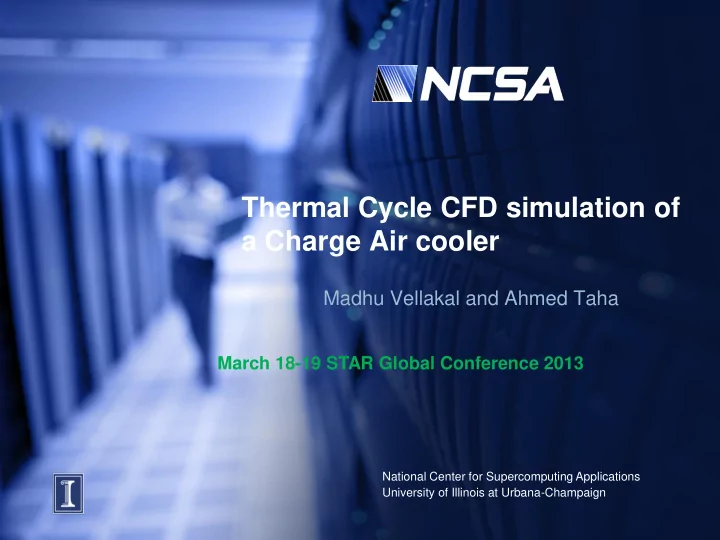

Thermal Cycle CFD simulation of a Charge Air cooler Madhu Vellakal and Ahmed Taha March 18-19 STAR Global Conference 2013 National Center for Supercomputing Applications University of Illinois at Urbana-Champaign
Who are we? • Private – Sector Program National Center for Supercomputing Applications @ UIUC • – High performance computing resources, consulting, benchmarking for Industrial users • Technical consultancy • National Digital Engineering and Manufacturing Consortium (NDEMC) • Public-Private consortium - focusing on providing high- performance impact to small and medium manufacturers. • Private investors & Public funds • Technical providers - NCSA, Ohio Supercomputer Center, and Purdue University STAR Global Conference 2013 Imaginations unbound
Objective • Simulate Thermal Fatigue Cycle test using CFD, FEA and Fatigue Analysis • Successfully train and educate SME (Small and Medium Enterprises) on Modeling and Simulation • To reduce physical testing time and expedite product development in SME’s design process STAR Global Conference 2013 Imaginations unbound
Problem Statement • Develop methodology and resources to digitally simulate the charge air cooler (CAC) thermal cycle test • Charge Air Cooler – Thermal stress during operation • Thermal Cycle test – Required to validate design • Transient Conjugate Heat Transfer Simulation • Solve for Fluid and Solid Temperature • Thermal value from CFD can be mapped onto Structural Model • Stress induced due to temperature distribution can be calculated using FEA • Output from FEA is used for Fatigue Analysis STAR Global Conference 2013 Imaginations unbound
Simulation Driven Development • Physical Testing Time – in months • Simulation Time – Pre-Processing to Post-Processing in weeks • Possibility to simulate different designs • Gives better insight about the Physics STAR Global Conference 2013 Imaginations unbound
Geometry • Inlet and Outlet Tanks • Tubes with Fins for Heat transfer • Air Fins for heat exchange and Headers for Support STAR Global Conference 2013 Imaginations unbound
Mesh • Polyhedral and Prism layer mesh for fluid and solid parts • Extruded the tubes to minimize the mesh size • Utilized Embedded Thin mesher for thin volumes • Mesh size is about ~15 million elements STAR Global Conference 2013 Imaginations unbound
Simulation Setup • Fluid • Unsteady • RANS – SST K-Omega • Segregated Flow and Temperature • Polynomial Density • Air • Solid • Segregated Solid Energy • Constant Density • Unsteady • Aluminum STAR Global Conference 2013 Imaginations unbound
CPU’s Time / cycle (hrs) 16 40 Benchmark 32 40 64 28 16.4 128 iForge – 2048 Intel Cores 512 15.14 1024 12.7 STAR Global Conference 2013 Imaginations unbound
Results- Temperature Distribution STAR Global Conference 2013 Imaginations unbound
Results – Velocity Contour STAR Global Conference 2013 Imaginations unbound
Results – Vector Plot STAR Global Conference 2013 Imaginations unbound
Results – Streamlines STAR Global Conference 2013 Imaginations unbound
Cycle-Cycle Comparison - Simulation STAR Global Conference 2013 Imaginations unbound
Cycle-Cycle Comparison – Experiment 140 Seconds 420 Seconds 280 Seconds STAR Global Conference 2013 Imaginations unbound
Next Steps • Transfer Thermal data onto a FEA model using Data Mapper within STAR-CCM+ • Perform FEA Analysis using ABAQUS • Coupled Fluid-Structure Interaction Analysis using STAR-CCM+ & ABAQUS • Validation of the CFD model STAR Global Conference 2013 Imaginations unbound
Acknowledgement • SME partner for model creation and setup • OEM Partner and NDEMC for the support • PSP & NCSA for computational and technical resources • CD-adapco for meshing tech support STAR Global Conference 2013 Imaginations unbound
Thank you! STAR Global Conference 2013 Imaginations unbound
Recommend
More recommend